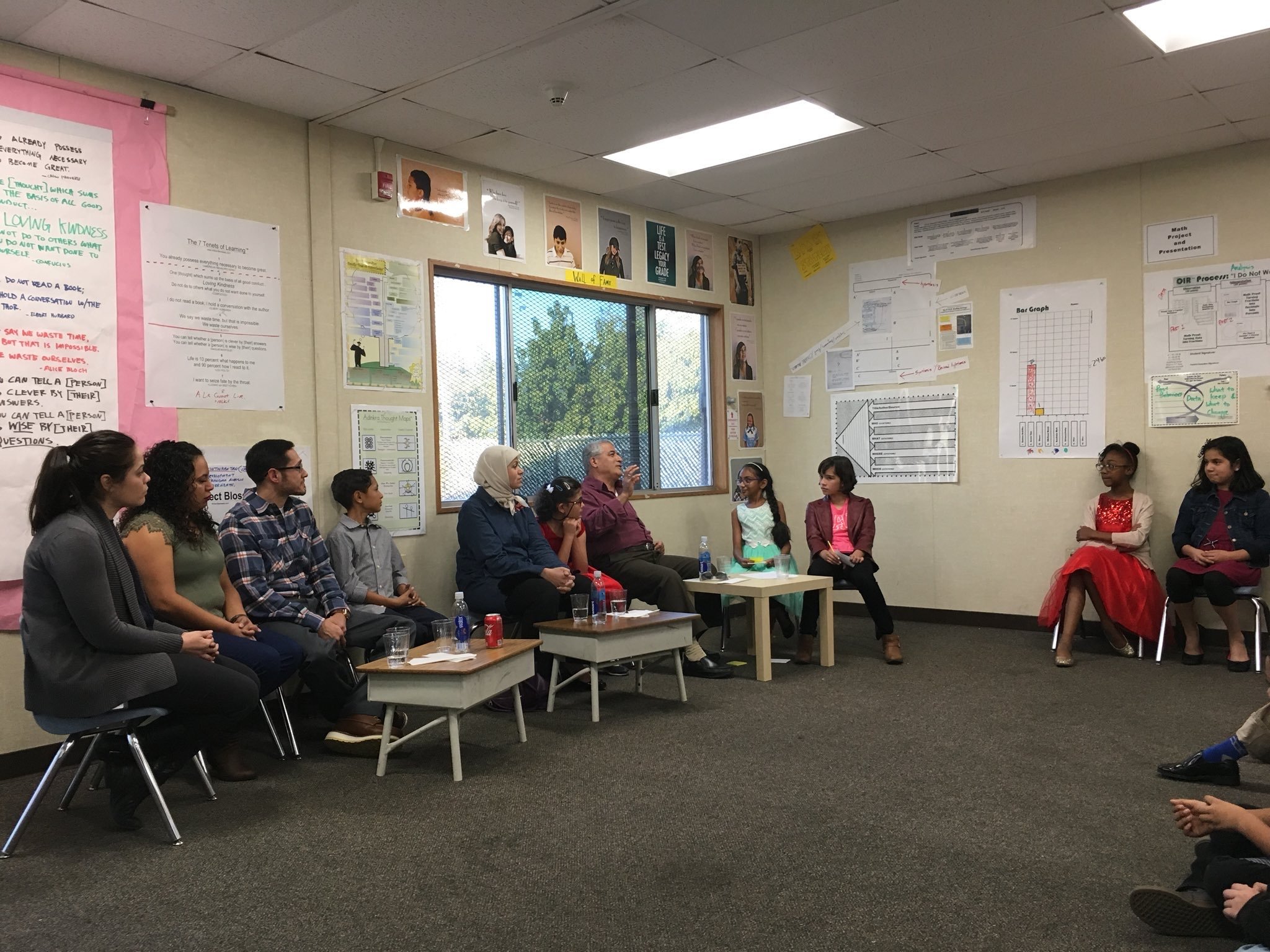Al Najm
Al Najm: Re-Envisioning the Classroom as an Innovation Hub
Al Najm is the most dynamic and productive research and development component in Mr. B's classroom. This success is due to the collaboration between Mr. B and Professor Oraib Mango, a World Languages Professor at Cal State San Bernardino. Their shared passion has led to an unpredictable evolution of pedagogy and praxis that goes beyond what can be taught in professional development training, advanced degrees, or the traditionally rigid educational systems that many creative teachers navigate.
Over the years, numerous experiments have shaped the conceptual art program, pushing the boundaries of potential for both the teacher and the professor. The following is an exploration of this evolving relationship and the families they serve.
The First Al Najm Class
Year 1 of Najm focused on teaching CSUSB undergrads to teach Arabic to a 5th Grade class at Salinas Elementary. The class created an all Arabic play along the traditional folktale of Jonah and the Donkey. The Onion Model of Lesson Planning began in development as a tool for introducing teaching to non-teachers based upon deeper themes flowering into practical lessons.
The Holy Trinity in Portuguese: Teaching Beyond Expectations
In an effort to move beyond traditional teacher training programs that often focus on appearing busy rather than fostering meaningful development, Al Najm emphasizes alternative approaches to learning. Influences include Paulo Freire, Augusto Boal, the Reggio Emilia approach, Studs Terkel, early Civil Rights training at the Highlander School, and early philosophies such as Socratic Questioning, Stoicism, and Cynicism.
Freire’s Cultural Circles, a form of Socratic Circles, have become a core method for processing information using collective intelligence. Mr. B’s philosophy views the classroom as a single organism, "The Hive," composed of 30+ individuals who share a collective language, culture, and thought process, distinct from the consciousness of any one individual, including the teacher. Therefore, successful teaching begins with understanding the language the class speaks.
For new teachers, Mr. B recommends studying the educational philosophies of Brazil. The "Holy Trinity" includes educator Paulo Freire, thespian Augusto Boal, and Jujitsu innovator Helio Gracie.
Theater of the Oppressed.
Students and staff engage in Image Theater where the audience of a play performance participate collectively to document, debate, and process obstacles to learning in a typical classroom.
Community Maker Spaces: Empowering Parent Engagement
Many parents often feel disconnected from the school community, viewing themselves as mere visitors rather than integral members of the school family. Maker spaces provide a strategic approach to enhance parent involvement while humanizing teachers and making them more approachable partners in their children's lives.
The concept is straightforward. By organizing activities such as collaborative set-building for school plays or using recipes to teach the math concept of measurement, parents are encouraged to actively participate. For those who may be hesitant, offering simple tasks ensures everyone can contribute comfortably, even as teachers join in and occasionally make a mess of things, fostering an understanding that teachers are learners too.
Imagine a skilled educator engaging in friendly banter, perhaps even “accidentally” burning some cornbread during a demonstration. This humanizes the teacher, encouraging mothers and fathers to step in and collectively guide the class. As a result, parents often feel more confident and open to dialogue during future activities involving all learners and educators.
The Evolution of Language: Understanding Cultural Narratives
Al Najm students have embraced a significant evolution in their learning—mastering the art of listening and questioning. They delved into cultural narratives, recognizing them as not just records of history but also as lenses through which we interpret the human experience. Exploring weighty texts like Alan Gratz's Refugee and the profound oral histories of Studs Terkel, such as CP Ellis (Klan member turned advocate), students dissected character arcs and the complexities of humanity's capacity for both inhumanity and compassion.
This journey culminated in students documenting their own family histories, ensuring these stories are preserved for future generations. The pinnacle was a poignant group interview with two immigrant families, highlighting diverse yet strikingly similar experiences of immigration between families immigrating from Mexico and Jordan.
Icons of Immigration and Vulnerability
As educational content evolved towards more emotive and profound learning experiences, curriculum adjustments became essential. The Icons of Immigration provide a structured lens through which the challenges of adapting to new cultures are explored, fostering deeper understanding in the classroom.
Moving to a new culture involves significant shifts in resources, access to information, and a pervasive sense of insecurity. This dynamic often exposes individuals to predatory risks, underscoring the importance of recognizing and mitigating such challenges for success and survival. The Icons of Migration assist teacher and student to process these complex ideas with analytical filters that serve well in debate, writing, and reading comprehension.
To aid in these discussions, we offer a free PDF of the Icons with an additional set tailored for use with the poetically-based novel Inside Out and Back Again by Thanhha Lai.
Sample syllabus from early Al Najm symmester.
smARTshow is the latest focus of Al Najm. Click to see how conceptual art is the perfect theraputic and higher-level thinking medium for students.







